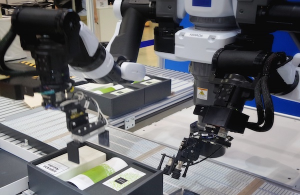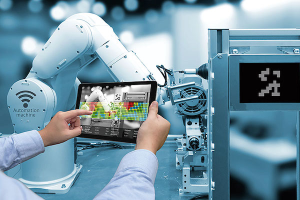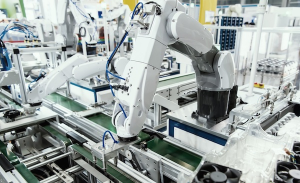Traditional manufacturing was characterized by a limited level of data exchange between machines, systems, and processes. The advent of Industry 4.0, or the Internet of Things (IoT), fundamentally reshapes CNC basics and the industrial landscape. CNC machining industries now use smart connected manufacturing solutions that connect every aspect of production, from data to operations and quality management.

The connected smart CNC parts factory enables computer-driven systems to make decentralized decisions with much higher levels of accuracy and precision. With an ecosystem of connected factories and automated machines, manufacturers can allocate resources optimally and customize the output. This offers seamless transitioning between digital and physical design, construction, and production.
The connectivity of the smart connected factory provides end-to-end service and data visibility throughout the product development cycle. Let’s examine CNC machining industries use smart connected factories to drive optimal results.
Role of Smart Connected Factories in Automated Manufacturing
Smart factories utilize advanced technologies such as sensors, cloud computing, IoT, big data analytics, and augmented reality to operate machinery and hardware digitally. With artificial intelligence, control systems, mobile edge computing (MEC), and many more, these factories automate physical production, improve design processes, and achieve greater preventative maintenance.
As the digital transformation era progresses, we are witnessing increased connectivity and automation on three different levels:
●Level #1: Basic Data Acquisition
Modern database technologies and artificial intelligence enable the collection and integration of diverse data sets. These data sets come from various sources, such as the business, supply chain, and the world at large. The Industrial Internet of Things (IIoT) gathers data from connected machines through sensors and gateways.
Likewise, AI-powered systems can compile market trends, performance, logistics, and other relevant data from numerous portals. However, simply having data does not make a smart connected factory, which brings us to the next level.
- Level #2: Proactive Data Analysis
A smart CNC parts factory uses machine learning, advanced analytics, and modern data management solutions to make sense of diverse data sets. Market and operational data identify opportunities and risks. At the same time, IIoT sensors alert when machines require repair or servicing.

With the appropriate systems in place, it is easy to analyze workflow efficiencies over time for optimal performance. There are infinite possibilities for digital factory optimization and supply chain forecasting. This level of data is centrally available and more structured for better understanding.
- Level #3: Intelligent Factory Automation
Workflows are established after data acquisition and analysis. Instructions are sent to machines and devices within the system. It could be within the CNC parts factory walls or in the supply chain. Manufacturers ensure the continual optimization of smart workflows. For instance, if demand for a product increases, 3D printer workflows can be instructed to prioritize production.
Based on the three levels of operations, CNC machining industries take advantage of smart connected factories to achieve outstanding results.
Real-time Decision Making
The connected CNC machining center in today’s industry use their own AI-enabled, real-time decisions. An efficient combination of data collection and predictive analysis enable effective control and automation of processes to ensure the seamless running of production.
At the same time, machine learning and AI assist in creating insights with minimal human supervision. The system is highly automated and can predict potential failures proactively. The management can remotely monitor workers, machines, and equipment with long-range wireless sensors. As a result, data-driven decisions can be made to transform manufacturing processes and value.
Valuable Data Insights
Smart connected factories provide real-time insights and recommendations to all levels of the manufacturing process through cloud connectivity and end-to-end visibility. This enables rapid customization and response to changing trends, resulting in products that closely align with customer needs. Through advanced analysis of system data, weaknesses and areas for improvement can be quickly identified.
Ultimately, businesses can achieve increased competitiveness, positive product reviews, and reduced returns or recalls. The IIoT data is the “currency” of a smart connected factory, driving reactive, predictive, and transformative value for both humans and machines. This actionable data activates the IoT’s value across the entire factory, from faster corrective actions to predictive management and transformative innovation.
Smart factories reduce reactive practices and shift to more responsive and resilient supply chain management through predictive analytics and Big Data analysis. This results in optimized processes, adequate inventory management, accurate demand forecasting, and improved speed to market. The digital insights provided by smart factories streamline efforts and enhance overall productivity.
Quick and Safe Manufacturing Processes
Traditional CNC machining industries have achieved automation through robots or computer-aided planning. However, smart factories go further by optimizing their processes based on usage metrics. These factories use sensors and automation to monitor and control the manufacturing process, allowing for fast adjustments and corrections as needed.

AI and machine learning allows for constant monitoring and data-driven improvements, making production more flexible and efficient. Smart factories also prevent unexpected shutdowns and malfunctions and protect digital assets with encryption. This enhanced awareness can extend across the entire manufacturing supply chain.
In addition, smart factories can implement safety protocols and procedures that are designed to protect workers and prevent accidents. This can include using sensors to detect potential safety hazards and automatically shut down equipment if necessary. It also consists of the implementation of safety training programs and procedures. Overall, a smart CNC parts factory leverages modern technologies to enable businesses to adopt more sustainable, safe, and environmentally friendly manufacturing practices.
Conclusion
The advent of smart connected factories has revolutionized the manufacturing industry. It provides various benefits that positively impact production, safety, efficiency, and profitability. The exciting thing about transformation into a smart CNC parts factory is that it does not happen all at once.
As businesses strive towards full integration of smart factories, every step taken towards modernizing and optimizing their digital systems brings them closer to achieving this goal. With real-time monitoring and data analytics, smart factories can quickly adapt to changing market conditions and customer demands. By embracing these technologies, manufacturers can gain a competitive edge and drive innovation in the industry.

